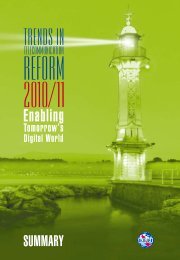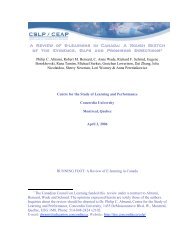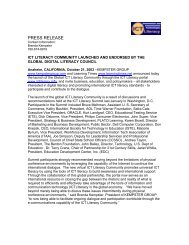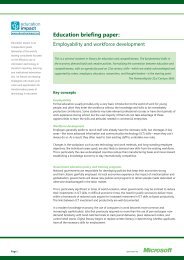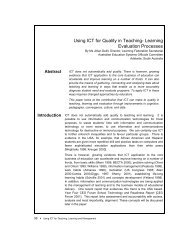147 pages pdf - ICT Digital Literacy
147 pages pdf - ICT Digital Literacy
147 pages pdf - ICT Digital Literacy
You also want an ePaper? Increase the reach of your titles
YUMPU automatically turns print PDFs into web optimized ePapers that Google loves.
Pedagogy & Webagogy -- Ready, Set … TRAIN and FACILITATE!<br />
#575: Those Who Can, Teach<br />
As instructors for e-Learning: keep it interactive, keep your voice loud enough for everyone to<br />
hear, display enthusiasm, and know how to use the tools of the trade.<br />
Connie Fluegel<br />
BMC Software, Inc.<br />
#576: Teach to Match Your Objective<br />
When skill-building is the primary objective, it is critical to force interaction to both improve the<br />
participant experience and to enable faculty to gauge comprehension. Effective techniques<br />
include cold calling (calling on individuals before waiting for virtual hands to be raised), informal<br />
polling (asking the group questions and having them click to agree or disagree), formal polling<br />
(providing the group with multiple choice survey questions), and text chatting (communicating in<br />
a text chat room.) If your objective is wide awareness of content, you can engage people<br />
without two-way interaction, provided it is for short bursts of time and the content is compelling.<br />
Lynne G. White<br />
Accenture<br />
#577: Build In the Orientation<br />
Front load the first couple of classes in a hybrid course (or one that will be supported with web courseware) with<br />
an explicit e-Learning orientation so that there is no doubt in the student's mind as to what is expected to be<br />
successful in the course. Make sure you have done your homework as the teacher vis-a-vis all of the e-Learning<br />
resources in your institution that can be used to support the students in your course. If you are not familiar with<br />
them and what they offer, chances are your students will not use them. Think as well about keeping track of<br />
support they are not receiving and pass this information on to the appropriate departments.<br />
Gail Allan<br />
Algonquin College<br />
#578: Plan For Chatroom Hours<br />
Open a chatroom in the morning of any day so that any learner or number of learners can set a<br />
time to enter and carry on a discussion.<br />
George Drops<br />
National University<br />
#579: Reach Out<br />
Provide encouraging feedback really quickly -- especially for new online learners at the start of a course.<br />
Jane Anderson<br />
TAFE Global<br />
#580: Personalize The Start Of The Course<br />
Send a welcome letter to students 2-3 weeks before the start of the semester or course. Include the URL of the course<br />
homepage, instructions for logging in, textbook or material information (including how and where to order), and<br />
instructions for the first day/first week. Provide a means for the students to check their computer system and login before<br />
the official first day of class. Also include a Frequently Asked Questions List and refer students to it. Create a student<br />
lounge in the discussion board where students can make casual postings to one another to build community. This will all<br />
help you to provide a personal touch from the beginning and ensure that everyone is getting the information they need.<br />
Karla Embleton<br />
Iowa State University<br />
#581: Use Text Appropriately<br />
When using narration and text, do not read the text aloud. Use text to support the narration and vice versa.<br />
This will result in greater retention and students will be less likely to stop listening or stop reading.<br />
Marc Sebes<br />
Digitas<br />
701 e-Learning Tips by The MASIE Center www.masie.com 114






